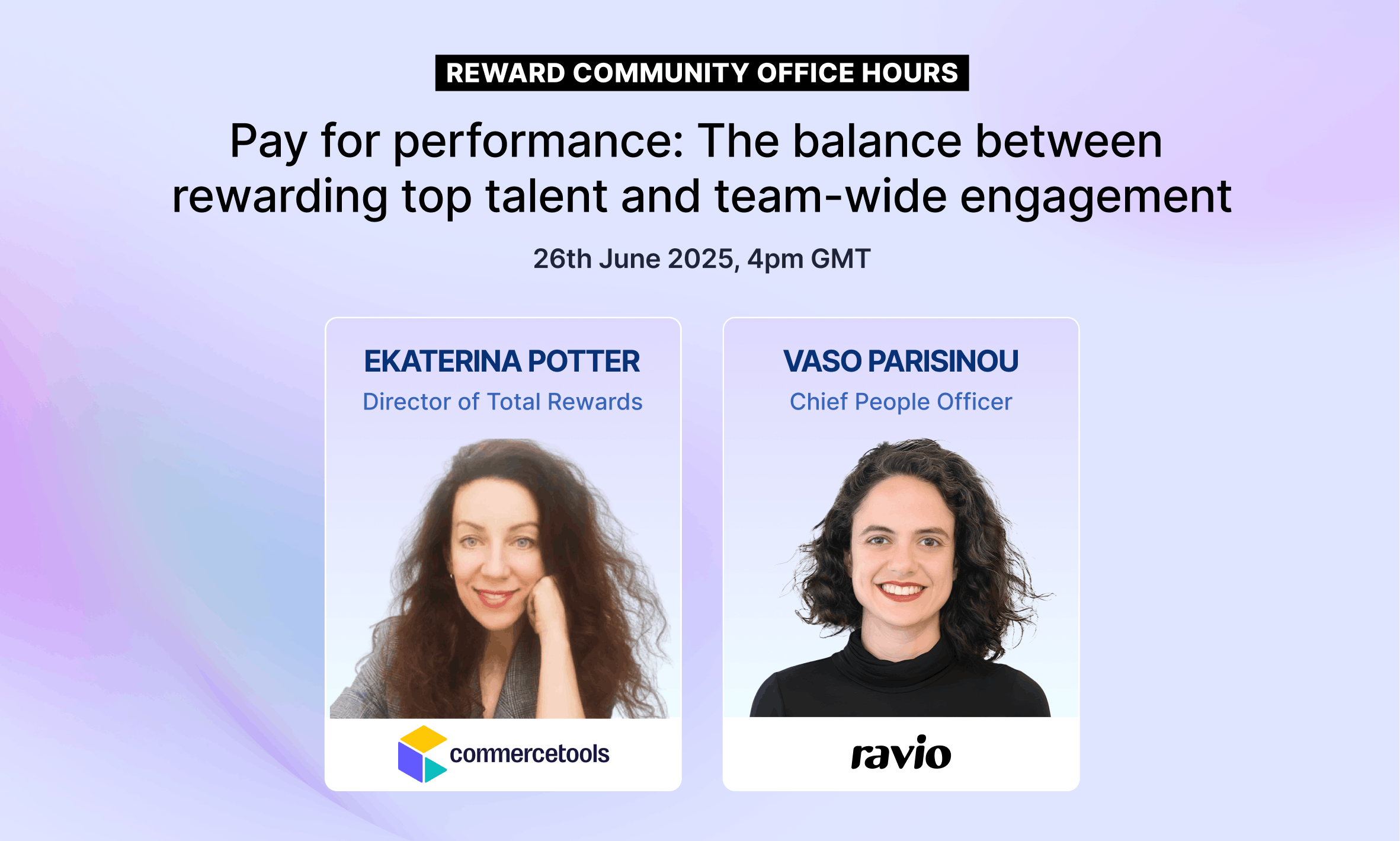Pay for performance sounds straightforward in theory – reward your best people more, and they'll stay motivated while driving better business results. But in practice, it's one of the most complex challenges compensation leaders face.
How do you objectively define a "top performer"? What happens to your reliable, steady contributors when all the focus goes to standout achievers? And how do you handle high performers who are already at the top of their salary bands?
For our Reward Community Office Hours in June 2025, Ravio's Chief People Officer Vaso Parisinou was joined by Ekaterina Potter, Global Director of Total Rewards at commercetools, who shared candid insights on implementing pay for performance at a rapidly scaling tech company.
If you missed it, below you’ll find the full recording as well as the key takeaways and insights from the webinar.
Key takeaways from the webinar
Key takeaway 1: Performance evaluation requires structure to steer away from subjectivity
One of the biggest challenges with pay for performance models is ensuring consistent, objective evaluation of what constitutes "high performance" across an organisation.
Ekaterina shared how commercetools evolved from ad-hoc performance assessments handled primarily by C-suite leaders to a comprehensive system that involves all managers.
“One thing we’ve really changed is that now all managers are taken on a journey to work through performance management, ensuring they fully understand the need for it, grasp the different categories of how we evaluate performance, and are clear on all the concepts and terminology involved.”
At commercetools, a combination of several things helps to ensure that performance evaluations are as objective as possible:
- Annual performance ratings with formal calibration sessions
- Regular check-ins and feedback throughout the year
- 360-degree feedback systems
- Business impact assessment alongside individual performance
- Clear guidelines and training for all people managers.
Key takeaway 2: Not every organisation can (or should) consist of only top performers
A central theme of the discussion was challenging the assumption that companies should be aiming to hire and retain the best possible performers across the board.
“There’s always a significant proportion of the workforce that are solid, robust workers, and I believe that most organisations need those employees,” Ekaterina explained.
The speakers highlighted several important considerations:
- Financial considerations: Focusing only on top performers is a very expensive hiring and compensation strategy that most companies can’t sustain.
- Team dynamics: A team made up of 100% top tier performers would be one characterised by unsustainable pressure and constant threats of burnout.
- Role requirements: Not every position requires a stellar performer – some roles need reliable, consistent execution, and companies should be clear on which are which to match the company’s needs and goals.
- Personal preferences: Not all employees want increased responsibility or progression towards leadership roles.
- Seasonal performance: Even the best-performing employees go through different phases in their careers and personal lives which impact how they’re able to show up – and companies should be supporting their team members through those moments, not adding pressure to maintain top performance.
This doesn't mean accepting mediocrity, but rather recognising that a healthy organisation needs different types of contributors.
💡 Ideas for supporting your reliable performers:
- Ensure sufficient budget for meaningful increases that address inflation and market adjustments for all employees, whilst also ensuring there’s enough differentiation to reward top performers commensurately
- Create development opportunities that don't necessarily lead to promotion, such as recognition programmes or career growth through project leadership, mentoring, or cross-functional work
- Design wellbeing programmes that support employees through different life seasons
Key takeaway 3: Top performers at the top of salary bands need creative solutions
One of the most practical challenges discussed was how to reward high performers who are already at or above the maximum of their salary range without creating outliers – a common situation as companies mature and high performers accumulate increases over time.
The poll results from the webinar showed this is a widespread challenge, with lump sum bonuses (44%) and salary increases (23%) being the most common approaches.
Ekaterina shared commercetools' approach: “Our managers are instructed not to put forward salary increases that would make team members exceed their range. In some exceptional cases where there’s clear justification we will allow increases above-band, but typically we look to pull other levers to reward that individual for their contributions.”
For those at or above band maximum, commercetools uses:
- Lump sum bonuses to avoid compounding the problem of having employees permanently above range – with differentiated amounts based on performance level
- Equity grants (for the same reason)
- Progress towards promotion through offering high-impact projects or learning and development opportunities
Final thoughts
Perhaps the most important takeaway from the discussion was Ekaterina's emphasis on peer-to-peer learning: "Pay for performance is a topic where there isn’t one right answer, and I don't think anyone can have the ultimate knowledge on the subject – I’m seeing this discussion very much as a peer-to-peer exchange.”
That’s exactly why we run our monthly Reward Hours sessions: an opportunity for Reward leaders to come together to discuss challenging areas and hear how different companies approach those challenges in different ways.



